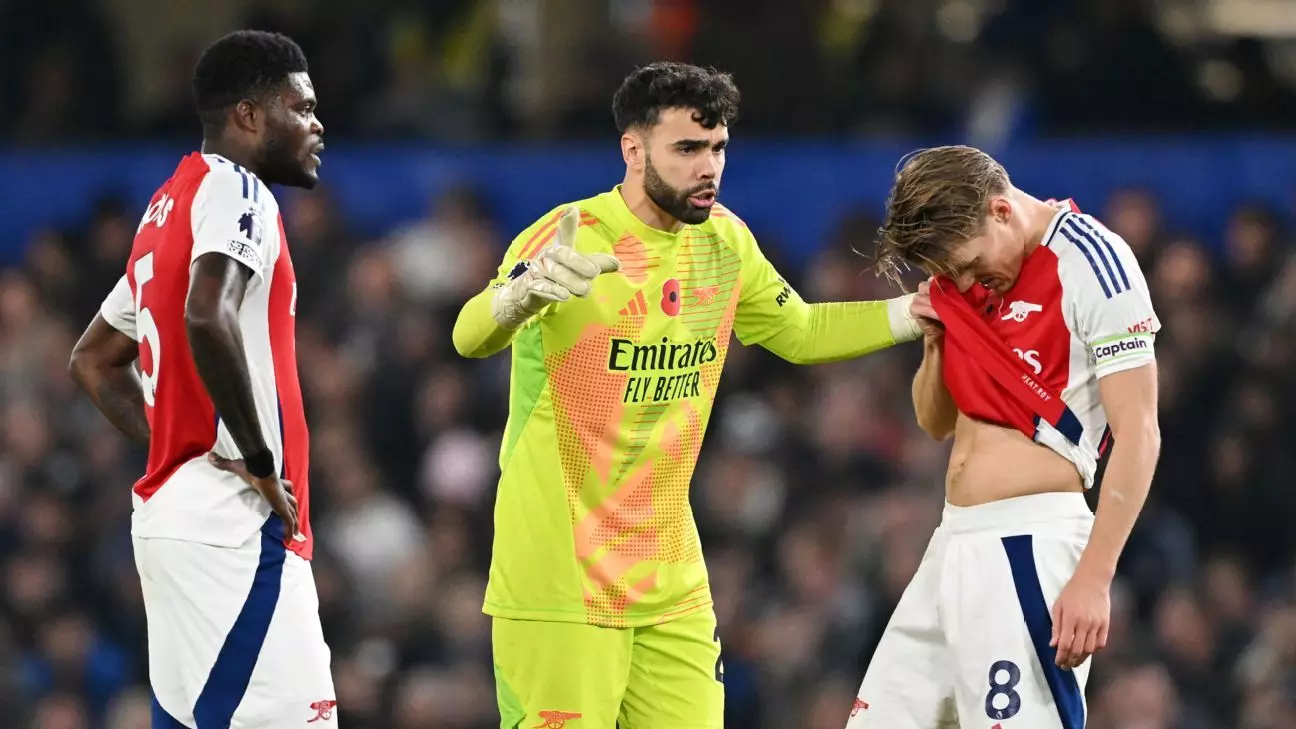In a highly charged encounter at Stamford Bridge, Arsenal and Chelsea played out a 1-1 draw that felt more like an opportunity missed for both sides. While the result offers little comfort, the match showcased a blend of tactical nous, individual brilliance, and the often cruel nature of football. The Gunners now find themselves nine points behind league leaders Liverpool as they head into the international break, struggling for form and consistency.
Mikel Arteta made changes to Arsenal’s lineup that hinted at his tactical flexibility, swapping out a 4-4-2 formation they had been using for a more compact 4-3-3 system. The intention was clear: to exploit Chelsea’s defensive weaknesses while establishing a stronghold in midfield. Yet, this strategy found itself challenged early in the match. Chelsea’s Cole Palmer, who had initially posed a threat with a powerful long-range effort, became a focal point around which their attacking play revolved.
Despite positive spells of possession and creativity from Arsenal, the team still exhibited defensive lapses. Gabriel Martinelli’s opening goal—an exquisite finish assisted by the returning Martin Ødegaard—was overshadowed by their collective inability to close down Pedro Neto shortly after. The Portuguese winger capitalized on poor marking, unleashing a powerful strike that equalized the game. This moment epitomized Arsenal’s defensive frailty, as they allowed a player as dangerous as Neto too much time and space on the edge of the area.
Ødegaard’s return from injury sparked hope among Arsenal fans. He displayed his playmaking abilities, highlighted by the pinpoint pass that led to Martinelli’s goal. However, his presence was also a reminder of the Gunners’ dependency on key players for creativity and fluidity in attack. With only one loss in 22 Premier League appearances when Ødegaard has played in 2024, his absence in prior matches has been acutely felt.
Yet, the narrative of Ødegaard as the catalyst for Arsenal’s attacking play was complicated by the Gunners’ overall tactical execution. While he set up Martinelli’s goal, moments later side-play resulted in Martinelli being substituted after Chelsea’s equalizer—indicating the precarious balance Arteta is attempting to maintain in games that turn on a single moment of magic or blunder.
On the flip side, Chelsea exhibited resilience that speaks to their current coach Enzo Maresca’s influence. The signing of Pedro Neto from Wolves had initially met skepticism, given the club’s existing attacking options. However, Neto proved his worth by not just finding the net but being integral to Chelsea’s attacking rhythms. His ability to switch flanks and create genuine threats consistently bolstered Chelsea’s attacking structure.
In this match, Neto demonstrated a knack for exploiting defensive weaknesses—a trait that showed how crucial wingers like him can be against organized defenses. His equalizing goal not only demonstrated his technical ability but highlighted the strategic miscalculations by Arsenal’s defense. This game served as a baptism of fire for Alec’s return, with the Brazilian’s impact pivotal to Chelsea’s recovery in the match.
The match also carried a poignant subplot with Kai Havertz’s return to Stamford Bridge, where he had previously enjoyed a storied career with Chelsea, including scoring the winner in the 2021 Champions League final. Now in the Arsenal setup, Havertz’s homecoming bore the weight of anticipation and scrutiny, especially since he had commanded a substantial transfer fee. His disallowed goal due to a marginal offside decision not only symbolized his enduring struggle to find his footing in a new team but also ignited the fans’ animated responses.
Havertz’s experiences on the pitch reflected the broader narrative of player identity and loyalty in football. His frustrated reactions—culminating in receiving a yellow card for dissent—depicted an athlete caught between his former glory and current reality. This clash raised questions about player integration in teams and their emotional baggage from past affiliations, which can linger during high-stake matches.
Ultimately, the draw left both teams with a sense of urgency as the international break approaches. Arsenal’s search for attacking fluidity continues, while Chelsea will look to solidify their position in the top three and refine their tactics to capitalize on late-match situations. Football, as witnessed in this gripping encounter, is often defined not just by the goals scored but by strategic missteps, missed opportunities, and the heartbreak that accompanies the beautiful game. Both teams head into the break with lessons learned, and the mandate to return rejuvenated and ready for the battles that lie ahead.

